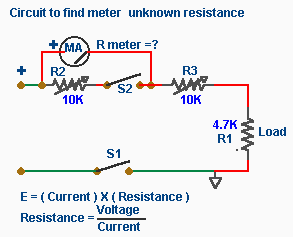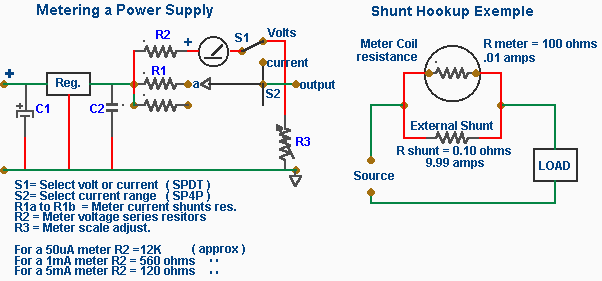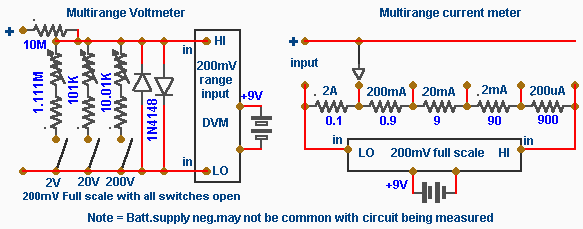Metering a Power Supply
Setting up a metering circuit for a regulated power supply is not difficult but requires accuracy in chosing the right shunt resistance across the meter. Knowing the meter current is sufficient to choose a resistance value( R2 ) for the voltage measurement as listed below but to get an accurate current measurement you must know precisely the meter internal coil resistance.
To find the meter resistance set-up the meter unknown resistance circuit as shown and proceed as follows; the first step is to find the meter internal resistance, the 4.7K resistance is used only to limit current . Start with the power supply set to zero volts , leaving S2 open and S1 closed . Raise the voltage slowly to a few volts and slowly increase the current flow by varying R3 until the meter needle moves full - scale deflection.
Without touching R3 close S2 and adjust R2 until the meter reads half of full - scale. The resistance of the meter and of R2 should now be equal. Open S2 and measure the resistance across R2. This value will now be equal to the internal resistance of the meter.

With a shunt connected across the meter most of the current is diverted past the meter. To determine the needed shunt resistance we will consider an example. If we want a 0 to 10 miliammeter to be able to read full - scale for a current of 10 amps. Therefore 10mA will flow through the meter when 9.990 Amps flows through the shunt.
If the meter resistance was 100 ohms, using ohm's Law the voltage across the parallel circuit is found by using the E( Volt ) equation ( below ) E = (0.01 amps ) X ( 100 ohms ) = 1 volt .Then by using the R equation R = 1 volt /9.990 Amps = .1001 ohms.

A shunt resistance can be calculated for any range you wish to apply to your meter scale such as 0 to 10 to read
0 to 10 mA , 10 to 100 mA ,100mA to 1 Amp and so on .
Many low ohm resistances are available . you can make your own shunts by using any kind of wire material you have on hand from spring wire to nicrhome wire , guitar strings , all of which have a small amount of resistance per inch . Since there is a .5V drop across most shunt R3( could be fixed) is use to adjust for full scale reading while in the voltage reading position.
As an option full metering can be used by hadding an additional meter for dedicated current reading with the scaling switching
as shown and removing S1 and connecting the voltmeter directly to the ground side. If a current limiting rehostat is used it would be very handy to be able to short the output while adjusting the rehostat for maximum current output resired as described in the DC Power Supply project
Metering With a DVM Module
 Back to supply
Back to supply

